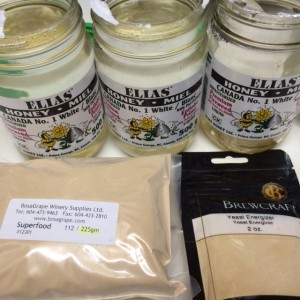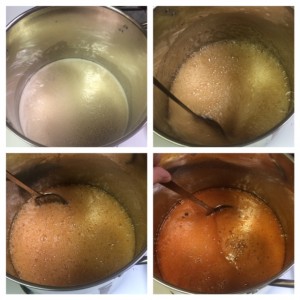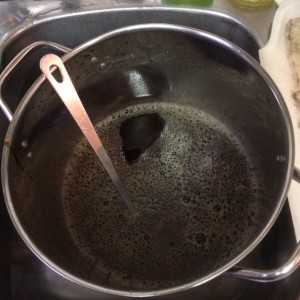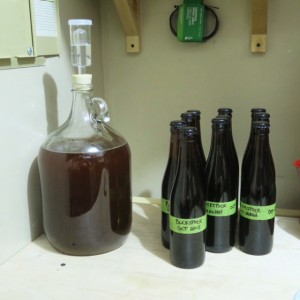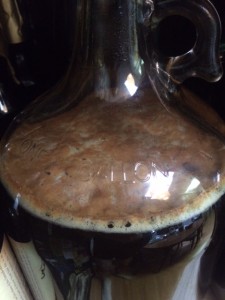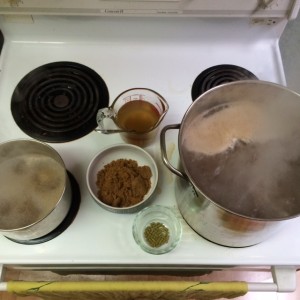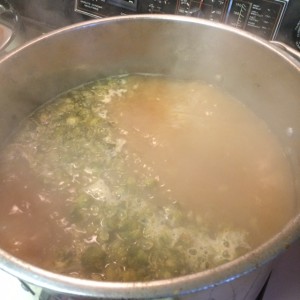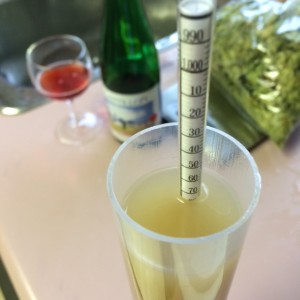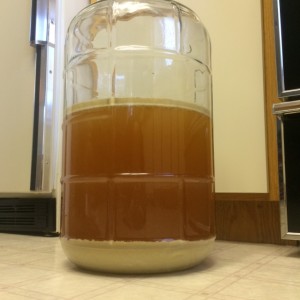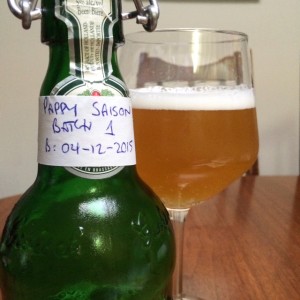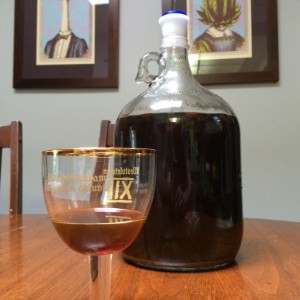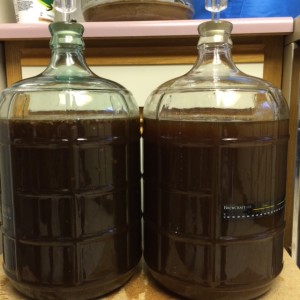[Brewed Oct 31, 2015] OG: 1.130 Est. FG: 1.027 ABV: 14%
It was only about a week ago I learned what a bochet was. Instantly intrigued, I planned to make one as soon as possible. I picked up what I needed during the week and it happened today.
I read a little bit on the process but preparations were minimal. I learned some things. I can tell you that while it doesn’t take very long compared to brewing a beer, there are no breaks. As soon as the honey comes to a boil, you can’t stop stirring it for more than a couple seconds at a time.
I used Fireweed honey as it lacks a lot of delicate fragrances that I’d be losing anyway during the boil. I added a stick of cinnamon halfway through the boil because it seemed like a good idea. I have never tasted a bochet, so I have no basis to go on.
This was the honey and nutrients I used. The only other things that went in were a 3″ long stick of cinnamon, Lalvin 71B-1122, and enough pre-boiled water to top things up.
I used 1/2 tsp of the superfood, and 1/4 tsp of the energizer. The 1500g of honey brings me to a calculated OG of 1.130, which is certainly on the high side. I am hoping that the yeast (Lalvin 71B-1122) will finish up around 1.025 – 1.027, which is the advertised 14% alcohol tolerance point of that yeast. That would leave me with a pretty sweet mead, but hopefully not overly so.
This shows the progression in caramelizing over about 25 minutes. It’s not very linear; it takes 10 – 15 minutes to show much change and then it darkens up fairly quick. It’s very hard to tell what the liquid’s colour is because of the incessant foaming. I cut the heat immediately after the lower right photo because I was just starting to pick up some ‘burnt’ smell. Before that it was marshmallows, leading into a very short toffee period then a touch of burning firewood smell.
I knew that at this point it is important to cool the mixture quickly. Usually this is done by adding a couple cups of hot water, which will spit and spew violently due to the super-heated temperature of the honey. I thought I was clever by opting to drop the pot into an ice bath to pre-cool the honey, but I was wrong. It immediately started sticking to the sides of the pot with incredible tenacity. Out of the ice bath it came, and I did things the way others have: add a cup of hot water and quickly cover while it freaks out for a couple seconds. Repeat until it stops freaking out, then add the balance of your water more expediently.
Since my top-up water was pretty hot itself, I cooled the whole mixture in an ice bath with constant stirring until room temperature. The liquid was darker than I had anticipated from the boil but as far as I can tell, it’s not overcooked. I am very interested to see how this turns out.
I added the re-hydrated yeast and put the airlock on. It’s now in my cellar at 62F where I’m hoping to find some activity in the coming days. Also shown is about 3/4 gallon of old ale (Buckstock) which I had bottled as well.
I will update on how its fermentation goes and how it ends up tasting. I don’t expect I’ll be bottling it until the end of the year, maybe even early next year. I plan to bottle it uncarbonated, and have already picked up 375mL clear Bordeaux bottles and cork T-caps for it because I am a massive dork.
[Oct 31, 2015] At 6 hours after pitching, activity has started. Bubble once every 4-5 seconds, some caramel colored foam building on the surface.
[Nov 1, 2015] At 20 hours, a thin krausen has fully formed (formed around the 12 – 14 hr mark) with a nice orange top and cream foam. Bubbling at around 40 bubbles per minute.
[Nov 5, 2015] The krausen has dropped, so I topped the jug up with about 2.5 cups of boiled then cooled water, a couple spoonfuls of honey, and 1/4 tsp of yeast ‘Superfood’. No gravity reading yet.
[Nov 14, 2015] Gravity 1.078, higher than expected at 2 weeks! Fed 1/2 tsp of superfood and 1/4 tsp of energizer boiled briefly. Smells strongly of Elmer’s wood glue, which I hope is just a product of the active fermentation!
[Nov 28, 2015] Transferred to secondary although the gravity has only dropped to about 1.059. That plasticy / wood glue smell is fading a bit. Hoping that an extended secondary will see some significant drop in SG still; I want a sweet mead but I’d like to see it in the 1.030’s. The taste is promising, despite being dessert-sweet it has nice complexity and the 10% ABV thus far is starting to balance it out somewhat.
[April 24, 2016] Bottled into 375mL clear Bordeaux bottles. Still has a bit of a glue-like note but otherwise quite nice. Likely still need some aging before it hits its stride.
[Dec 18, 2016] The glue smell has nearly completely dissipated now and the flavour is really quite nice. I shared a bottle with a number of friends and it was a unanimous hit. Very much a dessert beverage, it remained easily in the 1.050 range. However there is just enough alcohol to help balance it out a little bit, and the marshmallow and caramel flavours work really well. It would have been better to finish a little lower and now that I’m better equipped both equipment- and knowledge-wise, I look forward to giving this another try sometime.

